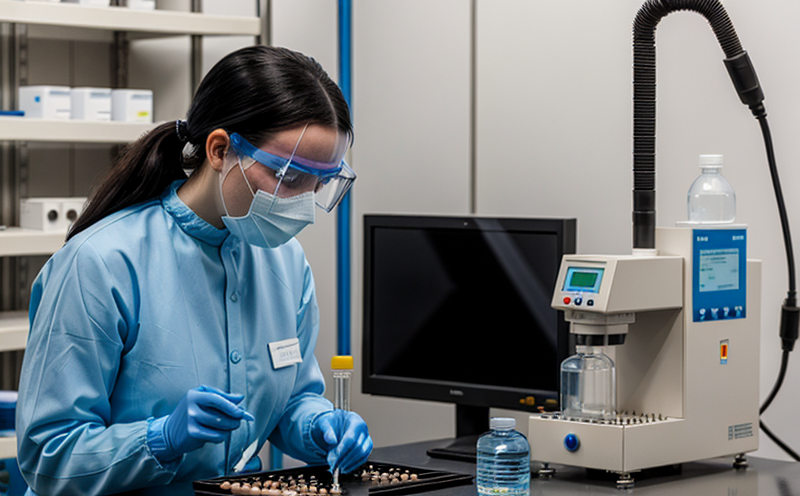GC Residual Solvent Testing USP 467
The USP 467 Chapter on Residual Solvents outlines a method for identifying and quantifying residual solvents present in pharmaceutical products. This is crucial not only to ensure product quality but also to guarantee the safety of patients who consume these medicines. The process involves the use of gas chromatography (GC), which separates compounds based on their physical properties, allowing precise identification and measurement.
Pharmaceutical manufacturers are required by regulatory bodies like the US Food and Drug Administration (FDA) and the European Medicines Agency (EMA) to adhere strictly to these standards. The purpose is twofold: first, it ensures that no harmful solvents remain in the final product; second, it provides transparency about the manufacturing process, which builds trust with consumers.
The GC method used for this test typically involves the following steps:
- Sample preparation: The sample must be dried and filtered to ensure accuracy. This step removes any extraneous materials that could interfere with the testing process.
- Injection into the GC system: Once prepared, the sample is injected into the chromatography column where it separates based on its components' boiling points.
- Detection: As each compound emerges from the column, it passes through a detector which measures its concentration. The type of detector used can vary but typically includes FID (Flame Ionization Detector) or TCD (Thermal Conductivity Detector).
The acceptance criteria for this test are stringent and are outlined in the USP 467. The method aims to detect residual solvents down to a concentration level of 10 ppm, which is well below any safety threshold. This ensures that even trace amounts of potentially harmful substances do not reach consumers.
The importance of this testing cannot be overstated. It plays a critical role in safeguarding public health by ensuring that all pharmaceutical products meet the highest standards of quality and safety. By adhering to these protocols, manufacturers can demonstrate their commitment to regulatory compliance and patient welfare.
Benefits
The GC Residual Solvent Testing USP 467 is essential for several reasons:
- Regulatory Compliance: By conducting this test, pharmaceutical manufacturers ensure that their products meet the stringent requirements set by regulatory bodies.
- Product Quality: Identifying and quantifying residual solvents helps maintain product integrity. This is vital for maintaining brand reputation and consumer trust.
- Patient Safety: Ensuring no harmful substances remain in pharmaceuticals protects public health and minimizes the risk of adverse reactions.
- Innovation Support: For R&D teams, this test provides critical data that supports ongoing product development efforts. It helps identify potential issues early on, facilitating more efficient problem-solving.
The results from GC Residual Solvent Testing USP 467 are not just a compliance exercise; they also serve as valuable insights into the manufacturing process. By regularly conducting this test, companies can monitor trends and make informed decisions to improve product quality further.
Why Choose This Test
The choice of GC Residual Solvent Testing USP 467 is driven by its reliability and accuracy in identifying residual solvents. Here’s why it stands out:
- Proven Methodology: The method has been validated through extensive research and is widely accepted within the pharmaceutical industry.
- High Sensitivity: It can detect even trace amounts of solvents, ensuring that no harmful substances are present in the final product.
- Standardized Procedures: The USP provides clear guidelines on how to conduct this test, minimizing variability and ensuring consistent results across different laboratories.
- Comprehensive Analysis: This testing method goes beyond mere detection; it also quantifies the presence of solvents, providing manufacturers with detailed information about their products.
The reliability of GC Residual Solvent Testing USP 467 is further enhanced by its use in conjunction with other quality control measures. For instance, it works hand-in-hand with methods such as HPLC (High-Performance Liquid Chromatography) and spectroscopy to provide a holistic view of product quality.
Environmental and Sustainability Contributions
The GC Residual Solvent Testing USP 467 not only benefits the pharmaceutical industry but also contributes positively to environmental sustainability:
- Reduction in Hazardous Waste: By ensuring that no harmful solvents remain in the final product, this testing method helps reduce hazardous waste. This is particularly important for environmentally conscious manufacturers who are committed to minimizing their ecological footprint.
- Eco-Friendly Manufacturing: The process of identifying and eliminating residual solvents encourages a more sustainable manufacturing approach. It promotes the use of safer alternatives and reduces the overall environmental impact of pharmaceutical production.
- Sustainable Supply Chain: By adhering to stringent testing protocols, manufacturers can ensure that their supply chain partners also meet these high standards. This fosters a culture of sustainability throughout the industry.
The commitment to environmental responsibility is reflected in the design and execution of this test. It exemplifies how quality assurance practices can contribute to broader sustainability goals. Through careful testing, pharmaceutical companies can play a pivotal role in promoting healthier environments for all.





